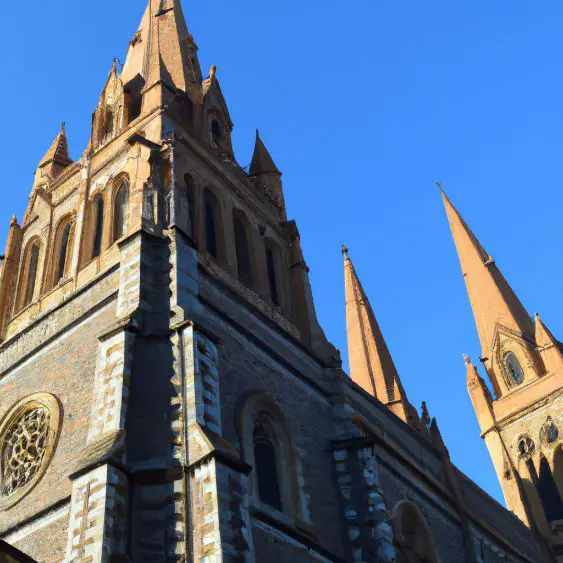St. Paul’s Cathedral : Interesting Facts, Information & Travel Guide

- By
- Aparna Patel
- |
- 19 Jun, 2023
- |

Welcome to the exquisite and iconic St. Paul’s Cathedral in London, England. With an aura of elegance and symbolism, the cathedral has attracted visitors from far and wide since it was built in the 17th century. This blog post will take you on a journey of discovery, providing interesting facts and information about the cathedral, as well as helpful tips for travelers who plan to visit this amazing and historic site. So, come with us as we explore St. Paul’s Cathedral, and uncover its amazing history and significance.
Table of Contents
Interesting Facts About St. Paul’s Cathedral
1. St. Paul’s Cathedral was the first Anglican Cathedral to be built in Australia.
2. The foundation stone for the building, laid by Bishop Charles Perry, is believed to have been made from stones mined in five countries including England, Italy, India, Ireland and Germany.
3. When St. Paul’s Cathedral opened on Good Friday in 1891, it was constructed from blonde bricks, with a roof of slate and mortar.
4. St. Paul’s Cathedral is a traditional cruciform building and is said to mimic the shape of a ship – a nod to Melbourne’s maritime heritage.
5. It’s bells, one of which dates back to 1660, can be heard from up to 6km away.
6. In 1907, St. Paul’s Cathedral was the venue for the first religious service to be broadcast on the radio.
7. Plus, in 2002, the first podcasted church service was also broadcast from the Cathedral.
8. The 1871 Bishop’s throne and the first year decorated bronze lectern are beautiful interior features of the St. Paul’s Cathedral.
9. Created by sculptor, Sylvia Levick, in 1966, the 16m long altar window is five meters in height and has been described as the ‘finest piece of stained glass in Australia’.
10. St. Paul’s Cathedral has hosted many royal visits, significant funerals and grand occasions since it opened in 1891, including the wedding of Queen Victoria’s youngest son, Prince Arthur.
History & Information About St. Paul’s Cathedral
St. Paul’s Cathedral is the Mother Church of the Anglican Diocese of Melbourne, Australia. It is located in Melbourne’s central business district in the square mile area known as “Cathedral Square”. It is among the most impressive cathedrals in the country and features an imaginative design based on the reflection of English Gothic architecture. The Cathedral was built in 1892 and designed by prominent British-born architect Aston Webb. The walls are constructed in brick and concrete and lined with sandstone and marble quarried in England.
The interior of the cathedral is quite impressive and features stained-glass windows as well as impressive statues, mosaics and wrought ironwork. The great organ was built by the famous English organ builders, Henry Willis & Sons and consists of more than 4,000 pipes.
The cathedral is noted for its important links with the Church and State of Victoria. It also serves as a memorial to Archbishop Charles Perry, the first Anglican Bishop of Melbourne since colonial times.
St. Paul’s Cathedral is popular with tourists, who come to admire its beautiful Victorian-era architecture as well as its history. It remains an important spiritual focus of the Anglican Diocese of Melbourne for believers and non-believers alike.
Travel Guide For Visiting St. Paul’s Cathedral
1. About:
St. Paul’s Cathedral is the Anglican cathedral for the Episcopal Diocese of Melbourne, Australia. It is located in central Melbourne on the corner of Flinders and Swanston Streets, and is the oldest and largest public religious building in the city. Designated as a “Minister for Cultural Affairs Heritage Place” in 2003, the cathedral has been an important site for religious and cultural life in Melbourne since it first opened for worship in 1852.
2. History:
Construction of St. Paul’s Cathedral was officially completed in 1856, though construction works on the building continued until the late 1860s. The Cathedral was designed by Augustus Pugin, and is one of the first works in the Gothic Revival style in Australia.
The iconic spire and tower of the Cathedral were largely destroyed by a fire in 1925, and underwent a major restoration during the early 1950s.
The cathedral is also the home of the Chapel of the United Archdiocese of Melbourne, which is the resting place of four former Archbishops of Melbourne.
3. Services –
St. Paul’s Cathedral is active in many aspects of the community and offers regular services and activities for parish members and visitors. Sunday services are held at 8:00am, 10:00am and 6:30pm, and evening services are held at 6:30pm on Wednesdays.
The cathedral also hosts a range of other activities throughout the year, including bible studies, youth groups, and other special events.
4. Photos & Tours:
Visitors can explore the cathedral and its grounds through guided tours, which take place on Saturdays at 10:10am. Tours cost $12 for adults and $10 for children. Photos are allowed throughout the interior of the cathedral however, visitors should be respectful and refrain from taking photos during services. For more information on tours and other events, please visit the Cathedral’s website.
Frequently Asked Questions About St. Paul’s Cathedral
Q. Where is St. Paul’s Cathedral located?
A. St. Paul’s Cathedral is located on the corner of Flinders and Swanston Streets in Melbourne, Victoria.
Q. What type of services are held at St. Paul’s Cathedral?
A. St. Paul’s Cathedral holds services every day of the week, including Holy Communion, Evening Prayer and Choral Evensong.
Q. What other activities take place at St. Paul’s Cathedral?
A. In addition to regular services, St. Paul’s Cathedral also holds concerts and special events throughout the year.
Q. When was St. Paul’s Cathedral built?
A. St. Paul’s Cathedral was originally built in 1883 and was restored in 1990 after a severe fire in the early 1980s.